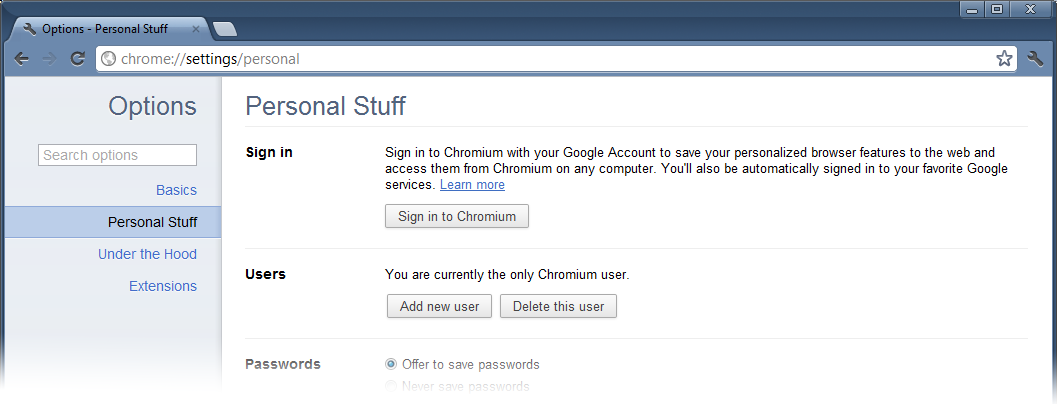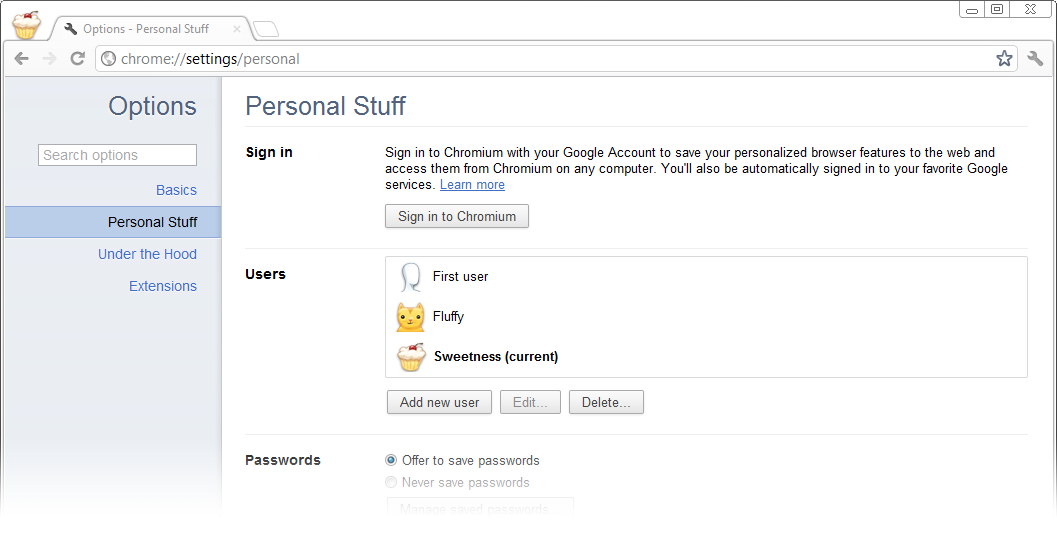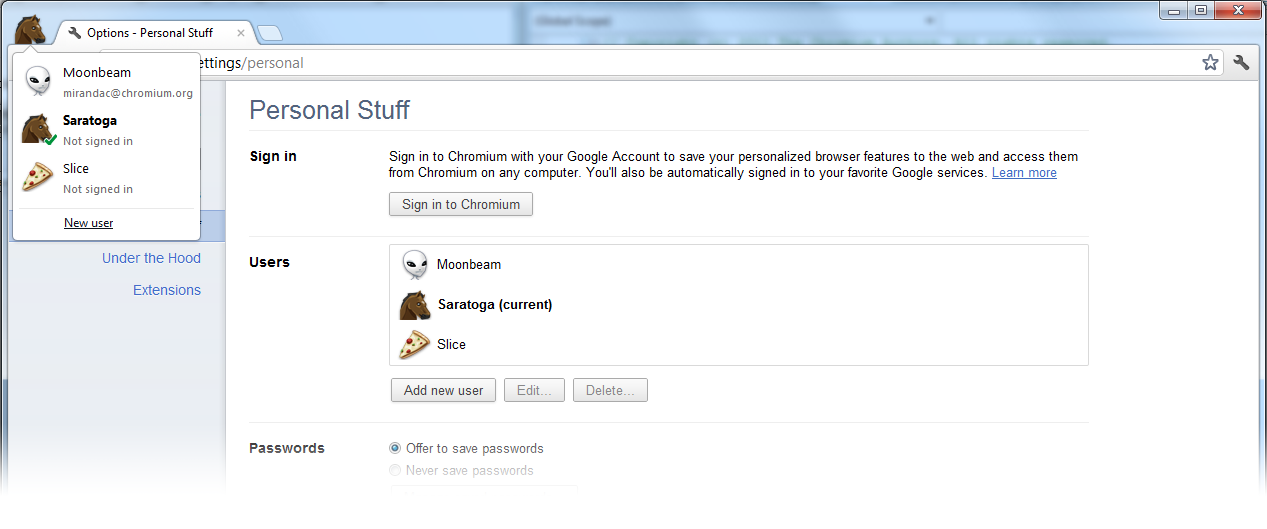Multiple Chrome Users
Overview
The multiple users feature allows the user to associate a set of preferences with a specific set of browser windows, rather than with an entire running instance of Chrome. Allowing different windows to run as different Chrome identities means that a user can have different open windows associated with different Google accounts, and correspondingly different sets of preferences, apps, bookmarks, and so on -- all those elements which are bound to a specific user's identity. Having multiple users in the Chrome browser also makes it easy to browse with separate identities without having to log in as separate users at the operating system level.
Sync and Multiple Users
Right now, Chrome provides a way of associating a Google account with a Chrome profile through the sync mechanism -- if a user "syncs" their browser, the user's apps, autofill data, bookmarks, extensions, passwords, preferences, and themes will be associated with the logged-in Google account and stored off-client, where they become available to the user on any browser on which they connect to their synced account. Sync provides the basic mechanism for binding a Google account to the state of a Chrome browser, but provides no special consideration for different users: the model provides that a browser is either synced to an account or not synced, and syncing adds data, instead of modifying it. For example, if a user syncs to account A and then logs out and syncs to account B, the browser will contain bookmarks from both accounts.
In the multiple users model, the idea of syncing will need to adapt to the understanding that several distinct users (or, at least, identities) can be associated with a single browser instance -- and that creating a personal account for the browser need not necessarily establish an off-client repository to save its state. There are two main issues here:
1. The user will be able to create a local account without enabling sync. This model can be seen as something like starting multiple Chrome instances with separate user-data-dir directories.
2. The user can have a local account with sync enabled; this state replaces the current binary "sync / not synced" model.
The act of syncing binds the synced browser window to an identity; thus the "sync" state is naturally part of the multi-user model -- indeed, it's the fully enabled state, where a user has a local account bound to a synced account in the cloud. If a user is running a local account which is not connected with a Google account profile and chooses to sync, they will be connected to their sync account as their Chrome identity. If they choose to create a local account without enabling sync, they will always have the option to enable sync in the options menu.
The First Account and Adding a New User
Users can take two actions to bind a browser window with a personalized account:
- They can add a new user. This creates a separate user account, with separate preferences and state.
- They can connect (or "sync") any user account to a synced Google account. This stores some of a user account's preferences and state in the cloud, where it can be synced to accounts on other machines.
The First User Account: When users runs Chrome without connecting to their Google account, they are using a basic, un-synced browser -- the "normal" mode for the vast majority of users now. When the user comes from this state and connects to a Google account, the preferences, bookmarks, history, etc. in this basic account at the time of creation will populate the initial user data directory for the new account. That is, this basic, default account will now be connected to the chosen Google account. If the user chooses to create a new account, a fresh, empty account will be created. If the user chooses to sync this account to an existing Google account, then the user's preferences from the chosen account will populate the new account. In either case, the initial account will remain accessible to the user from the profile menu as the "first user."
[Side note: right now, browser sync works differently from this. If a user syncs to identity A, then stops syncing, and then syncs again with identity B, the browser will end up with all the bookmarks from both A and B. This reflects the basic binary sync model of "sync/don't sync." If instead we have a model of multiple identities, following the sync model would mean that each new profile created would take bookmarks and settings from whichever identity is currently logged in -- leading to bloat, lack of control, and unwanted mixing of "personalities."]
Sign-in
The user will be able to add a new Chrome user from from the preferences/options dialog:
Launching New Windows
New windows will take their identity from the identity of the last active window. Active identities persist across sessions; if a user quits Chrome and then starts it again, the identity of the windows opened will be taken from the last window open when the browser last ran Chrome. Tabs will not be allowed to move across account boundaries; that is, one won't be able to drag a window from the browser belonging to account Alice to a window belonging to account Bob.
Incognito Mode
Every user account will have its own incognito mode. If an incognito window is launched, it takes its settings and preferences from the browser window which is currently active. We may need a special incognito mode UI to indicate which user the window is associated with; on the other hand, despite the fact that each incognito mode draws settings from a specific account, displaying the name of an account in an incognito browser window may give the wrong impression to users that their activities in this secret space are being associated with their identities.
Security
Because the data for all users which have been used for an instance of Chrome are associated with a single operating system identity, there is no expectation of special privacy. That is, there is no additional encryption of preferences and settings on the local machine other than that which already exists for user data directories in Chrome. Obviously, a password is needed to log in to a specific Chrome identity on the browser. However, no additional protection for the user data directories is planned. On Mac OS X, in fact, because passwords are stored in the commonly accessible keychain, it will be possible for a user in one account to access the passwords that have been stored on that machine by a user with another account.
Background Apps and Extensions
In order to properly handle background apps, which can run even after all browser windows have closed, Chrome will have to load all extensions for all accounts associated with a given Chrome instance when Chrome is launched, and launch background apps even if the particular user associated with them is not currently loaded. Because background apps will be controllable from the operating system, control of these applications can be safely and reasonably given to the user at this level, outside of the browser. That is, if a background app is loaded for Alice and only Bob is logged in, Bob will be able to turn off the settings for this application from the OS, without having to log in as Alice in the Chrome browser.
Browser Window Identity UI
Each browser window needs some visual tag to indicate that it is associated with a particular identity. This is accomplished with a personalizable avatar badge, in the spot usually occupied by the incognito spy. Once multiple users are set up for an instance of Chrome, the "Users" field in the personal settings menu is populated with a list of existing user accounts. Any user can add or delete accounts using this interface, and the avatar image and account name can be personalized through the settings page belonging to the account being edited.
User Launch Menu
The identity tag on the browser frame provides the option to launch a new window connected to an existing user account (any account which has been used in this browser will be listed in a dropdown), as well as the option to create a new user account. In addition, there will be the option of editing the account belonging to this browser (this account will be tagged with a check mark in the dropdown menu). If a user is signed in to a syncing Google account, that account's name will be displayed in the dropdown menu.
Disconnecting Disconnecting from an attached account will not result in any changes to the user's immediate browsing experience; the only change will be that alterations in the profile will not be synchronized with the profile state stored off-client.
For questions or comments, contact mirandac at google dot com.


